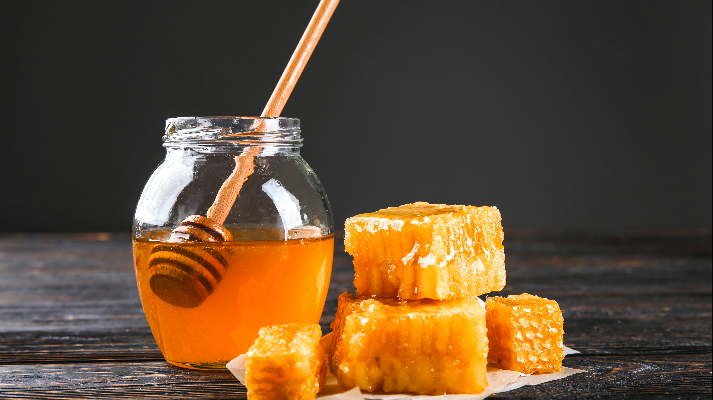How do I know that honey is original?
When buying honey, we all want to make sure that the product we have purchased is natural and original or not.
Despite the difficulty of these tests, and sometimes their inaccuracy, they initially help in detecting honey.
So...
If you want to learn ways to distinguish between original honey and adulterated honey, this article has been carefully collected for you.
But before we start, let's first get to know...
Ways to adulterate honey
It is initially important to know that honey can be:
- Natural raw honey: the best, which came directly from the beehive to you without processing.
- Pasteurized natural honey: to preserve its shelf life as long as possible.
In the two cases above, the honey is not considered adulterated.
But how can honey be adulterated then?
There are many ways to adulterate honey, so let us talk with you about the most important of these methods.
Starting with...
1- Collect honey before it is ripe
In order to get good natural honey with the best taste and benefits, it is important that the honey is completely mature so that it can be collected.
Thus, the proportions and components of the honey are different from the proportions found in the original honey.
This may happen because of the beekeeper's desire for speedy sales and production, or his lack of experience.
The maturity of honey can be determined by determining the amount of:
- Sucrose sugar.
- Viscosity.
- Humidity.
The second way to cheat is:
2- Add sugar to honey
Here, there is adulteration by adding two types of sugar:
- Sucrose.
- Glucose.
The goal of cheating in this way is to reduce the cost as much as possible.
You can detect cheating this way by:
- Determine the ratios of fructose and sucrose to glucose and vice versa.
- Proline assay.
- Determine the percentage of dextrins.
3- Mixing natural honey with artificial honey
To reduce the cost, some dishonest traders may mix both natural honey with artificial honey.
This reduces the benefits that can be obtained from honey.
Therefore, we always recommend purchasing from a reliable source to ensure the quality of the product you are purchasing.
Here this can be discovered with some difficulty, and the appropriate methods for this are:
- Examining the presence of pollen in honey.
- Taste the honey to know the flavour, but here you need to be an expert in honey.
- Hydroxymethyl furfural enzyme test.
4- Add water or starch
Although a large percentage of honey is water, adding external water to honey may greatly harm it and dilute its distinctive natural flavour.
Here you will discover the presence of water in the honey automatically, as it is left for 7 days to ferment.
As for starch, this requires laboratory analysis.
Here the laboratory adds iodine to the honey and the dominant color becomes blue or green.
5- Long storage or heating of honey
Although natural honey does not spoil, long-term storage may not be the best.
It is always better to consume a product as soon as it is produced.
As for thermally heating honey, this is a step that we are very wary of, because it may cause the loss of many enzymes.
Thus, honey loses a large part of its benefits.
To find out, all you have to do is examine the enzymatic activity of the honey to see if it has lost enzymes or not.
Another popular way to adulterate honey is to add a solution of corn syrup, which contains a large amount of fructose.
The solution here is to measure the ratio of glucose to fructose, and examine the proline and the ratio of potassium to sodium.
Now let's move on to the part you're here for...
What is the best way to know that honey is authentic?
The best way to know that honey is original is to laboratory test the honey and obtain a laboratory certificate of honey quality.
Unfortunately, these laboratories are not widespread enough to allow anyone to deal with them and analyze the honey they have purchased.
So ...
The solution now is to buy from a reliable source that already has these laboratory certificates of quality.
Here we recommend Asaloun ...
Assalon holds laboratory quality certificates for honey from two laboratories:
- Saudi Laboratory for Honey Quality.
- German QSI Laboratory.
What's also nice is that you always have the opportunity to return the product and get a full refund if the flavor is better at any other store, or you don't get results from the honey.
There are some other widespread methods, but they are incorrect and scientifically inaccurate.
Let us share it with you
How do I know that honey is original? (incorrect popular methods)
There are many methods that many people have resorted to to try to distinguish between original and adulterated honey.
Some of these tests are incorrect, others may be correct.
So in this part, let us share with you, 13 ways through which you can test honey and distinguish between natural and adulterated or with other ingredients added.
Let's start with...
1- Water test (inaccurate or correct)
The goal of this method is to know the rate of dissolution, and whether any external sugars are added to the honey or not.
Here we need 1/2 cup of warm water and a spoonful of honey.
Add honey to the water without mixing, and now to the result:
- Original: If a thick thread forms at the bottom of the cup and does not spread in the water.
- Adulterated: If you notice the honey spreading in the water.
2- The handkerchief test (inaccurate or correct)
One of the well-known popular methods to distinguish between original honey and adulterated honey is to put a drop of honey on a napkin or paper towel.
The aim of this test is to know the water content of the honey, and whether it has been adulterated by adding water or whether the honey is ripe or not.
Here it can be distinguished by the following:
- Original: If it is not absorbed and remains in a ball on the tissue.
- Adulterated: if it is absorbed by the tissue.
3- Finger test (inaccurate or correct)
Here the goal is to know the viscosity and consistency of honey. All you have to do here is put a drop of honey on your finger and follow the results.
- Original: If the drop of honey stays together on your finger and does not spread.
- Adulterated: If the drop spreads easily.
4- Ignition test (inaccurate or correct)
The goal here is to know the percentage of water content in the honey, or as it is also called the moisture test.
Here we need you to bring a match and a spoon of honey.
After that, put the matchstick in the honey, dry it, and try to light it.
- Original honey: If the match is lit.
- Adulterated: The oud did not catch fire, meaning the water content in the honey increased.
Note: This method is unreliable and incorrect.
5- Flavor test (inaccurate or correct)
Natural honey has a distinctive flavor due to the presence of flower nectar in it.
Although it is a very simple test, it is relied upon by honey experts.
Honey is:
- Original: If it has a distinct smell and flavor of floral nectar.
- Adulterated: if it is odorless.
6- Viscosity test (inaccurate or correct)
Here we need a glass bottle and put honey in it.
After that, tilt the container to the side, and notice how quickly the honey moves, and according to your vision, the honey will be:
- Original: if its movement is slow.
- Blurred: if its movement is fast.
7- Combustion test (inaccurate or correct)
Put a spoonful of honey in a pot and then put it on a stove.
Observe the changes that occur, and from here you can know whether the honey is original or adulterated.
- Original: If it turns black and sticks to the pot.
- Adulterated: if it burns.
8- Crystallization test (not completely accurate)
This test is a bit strange, but it is also reliable.
We shared before that low temperatures affect natural honey and make it crystallize.
Here the goal is to apply this. All you have to do is put a small amount inside a glass container in the refrigerator.
Honey is:
- Original: If it crystallizes and forms white crystals.
- Adulterated: If it is frozen or has no change.
9- Sand test (inaccurate or correct)
Surface tension coefficient is another way to distinguish between original honey and adulterated honey.
Natural honey has a high surface tension coefficient, and therefore this test was invented to measure this matter.
- Original: If the honey curls around itself and does not spread.
- Adulterated: If it is spread on the sand.
10- Taste test (inaccurate or correct)
Did you know that it is possible to distinguish between original and adulterated natural honey by tasting?
You can do this by eating a spoonful of honey. This honey is:
- Original: If the taste disappears in your mouth after 30 seconds.
- Adulterated: If the sugary taste in your mouth lasts more than 20 to 30 seconds.
11- Light test (inaccurate or correct)
This test is very simple but not very reliable.
It is known that original honey contains many additional ingredients other than honey, such as pollen or others.
The test here is by placing the honey in a glass container, then exposing it to light and looking at it.
Honey is:
- Original: if it contains some impurities.
- Adulterated: There are no impurities in it.
12- Vinegar test (inaccurate or correct)
Two drops of vinegar on a small amount of honey is all we need for this test.
Through this method, you can stand out as follows:
- Original: If no changes or reaction occur.
- Adulterated: when fizzing or foaming occurs with honey.
13- Ant test (inaccurate or correct)
It is said that this method is one of the methods that works to distinguish between the two types of honey.
But the truth is that it is not so.
Here the test is to let the ants approach your honey, and if they eat it, this means that the honey has excess sugar content or is adulterated.
If the ants do not approach the honey, this means that it is original natural honey because it is said that natural honey contains some substances that repellent insects such as ants.
Thus, we have answered the question, “How do I know that honey is original?”
I hope you really enjoyed it and got what you wanted.
If you have any questions, do not hesitate to contact us.

